The examples of student work on display in these four galleries are just a fraction of what may be found in the downloadable collections available on our Online Catalog. The Elements of the Waldorf Curriculum is the world’s largest archive of student work from Grades 1 to 8. To learn more, click here.
Galleries of Work by Waldorf Students
Grades Five through Eight
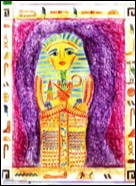
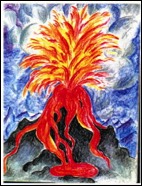
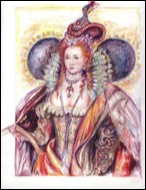
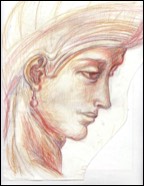
-
Grade 5 Galleries
-
Ancient CulturesThe study of the ancient cultures of India, Persia, Mesopotamia, Egypt, and Greece occupies a central place in the Waldorf fifth grade classroom. Students are immersed in the geography, mythology, architecture, sculpture, and poetry of each succeeding epoch, and the Grade Five class play is usually drawn from this study as well. We can see from these images what vivid impressions these classes have on the fifth graders. This is also a year when students' written work enters a new phase of clarity and expressiveness.

Click here to view the Gallery. -
BotanyHaving studied the lively and (usually) lovable world of Zoology in Grade Four, fifth graders now study the much less expressive world of the plants in Botany. As a class teacher, I always anticipated that my 11 year-olds would feel let down at having to study a much quieter kingdom of nature, and I was always surprised at the enthusiasm that they felt for the subtleties of the plant world. Once again, the wisdom of the Waldorf curriculum was in evidence -- and the fifth graders' love of Botany shines through their art work.
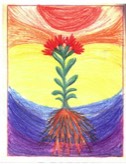
Click here to view the Gallery. -
Freehand GeometryGrade Five marks the culmination of the Waldorf student's drawing of forms freehand; in Grade Six she will receive a compass and straightedge and work in a very different way. The drawings that you see below were all drawn freehand, with colored pencils, by a fifth grader. Please observe the near-perfection of the circles and the care and precision with which the polygons and stellar forms were constructed. No drawing instruments whatsoever were used.
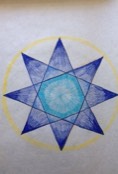
Click here to view the Gallery. -
North American GeographyIn Grade Four, the class studied "Local Geography," in which they learned the rudiments of map-reading and experienced how the relatively stable geological elements of their locality contrasted with the ever-changing cultural elements. In Grade Five, their horizons are expanded and they learn about the geography of their "homeland," which in schools in the USA means North America. As always, Waldorf school geography is, above all, cultural geography, and the biographies of individuals who were shaped by their surroundings is a central part of their study.
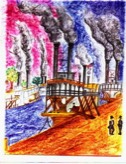
Click here to view the Gallery.
-
-
Grade 6 Galleries
-
Roman & Medieval HistoryFifth grade History surveyed a time period of eight to ten thousand years; Grade Six Roman and Medieval History explores a period that is much shorter (700 BCE to 1000 CE) but no less eventful. From the story of Aeneas, which takes the class back to the Trojan War, to the Seven Kings of Rome, to the tumultuous birth of the Roman Republic, to the life and death of Julius Caesar -- and much more -- sixth graders hear of lives and events in which the ancient gods play a very small role, while the nascent human individuality begins to take command.

Click here to view the Gallery. -
Astronomy & MineralogyLike Grade Two, of which it is many ways a "mirror image," Grade Six presents students with a number of polarities. Two natural sciences are studied this year: Astronomy, which encourages students to look up to the heavens above them, and Mineralogy, which compels them to keep their eyes on the ground below them. (It is hoped that these opposites lead to the balance that comes readily in Grade Five, but which is much more elusive in Grade Six.) In both sciences, a lot of time is spent outdoors: observing the stars, the sun, and the moon, or traversing rocky terrain to uncover the solid foundations below their feet. And, as in all Waldorf school sciences, everything experienced and learned is given artistic expression.
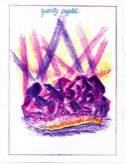
Click here to view the Gallery. -
EconomicsAlthough this block is still called "Business Math" in many schools, the newer name of "Economics" is a more accurate descriptor. In all that they study, sixth graders appreciate the opportunity to look into the "real world" and understand its implications for their present -- and future -- lives. In addition to reviewing fractions and decimals in the light of their newly-learned percentages, students gain a sense of how banks work, create a "shadow portfolio" of stocks that they track for many months, and start their own class business and assign various positions to classmates. Visits from parents involved in the worlds of business, finances, and even tax law help sixth graders comprehend the global ramifications of decisions that they make online or at the mall.

Click here to view the Gallery. -
Geometric DrawingHaving attained an apogee in their freehand drawing in Grade Five, sixth graders now receive a compass and straightedge (and perhaps a drawing triangle and T-square) and, sharpened 3-H pencils in hand, embark upon creating geometrical constructions with instruments. Most of their work will be based on the hexagon, the dodecagon (12-sided figures) and the icosakaitetragon (24-sided figures). The drawings you see below were drawn in the course of a three-week main lesson block. The focus and self-discipline needed to create them should be obvious, and the joy with which they worked shines through every page.

Click here to view the Gallery. -
PhysicsSince they were in the Waldorf Early Childhood Program sixth graders have been singing and playing musical instruments, drawing and painting. It is only natural, then, that their first laboratory science -- Physics -- would begin with Acoustics and Light and Color. Eschewing dry laboratory reports (as well as "demonstrations" that take place only a computer screen) Waldorf teachers bring these sciences to life with hands-on demonstrations and artistic renditions of what students have experienced and discovered.
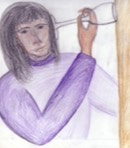
Click here to view the Gallery.
-
-
Grade 7 Galleries
-
Late Medieval HistoryThe seventh graders began their first History block looking back at the "Dark Ages" and then learned how such factors as the growth of towns, the rise of the guilds, and the expansion of Europe's world conception via returning Crusaders led to such transformative new steps as the Gothic cathedral, the rise of the university, and birth of city-states. The lives of Eleanor of Aquitaine and Joan of Arc epitomized the change and challenges of this time period.
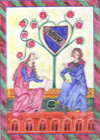
Click here to view the Gallery. -
Renaissance HistoryThe Renaissance History block is one of the most memorable in the entire grade school experience. The prototype of the "Renaissance Man" is so much in keeping with the educational philosophy of the Waldorf school that students feel a great kinship with the likes of Brunelleschi, Leonardo, and Michelangelo. This block also serves as a hub from which almost everything that they study this year: Mechanics, Physiology, Algebra, Perspective Drawing -- extend like so many spokes.
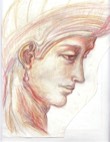
Click here to view the Gallery. -
Natural Science: Human PhysiologyHaving moved through the three "kingdoms" of nature in their preceding natural science blocks -- Zoology in Grade 4, Botany in Grade 5, and Mineralogy in Grade 6 -- seventh graders are ready to encounter the quintessential kingdom, the human being. The myriad changes going on within their own bodies awaken a profound interest in this subject. It is, of course, intimately related to the year's Renaissance theme, and the discoveries of such 16th and 17th century figures as Leonardo, Vesalius, Fallopio, and others is woven into their studies.

Click here to view the Gallery. -
Laboratory Science: ChemistryAs adolescence unfolds, the seventh grader becomes a human chemical factory as scores of "new" chemicals appear in his or her body. The Waldorf curriculum wisely waits until this grade to introduce Chemistry as a formal subject, although aspects of chemistry appeared in the study of photosynthesis in Grade Five Botany and in the study of the Lime Cycle in Grade Six Mineralogy. The primary work done in this year's study is the exploration of combustion and acids and bases.
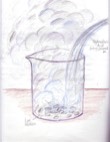
Click here to view the Gallery. -
Laboratory Science: PhysicsWhen they were in the Waldorf Early Childhood Program seventh graders joyfully played on the teeter-totter, and used brooms and shovels, dust pans and brushes. Seven years later, they are ready to bring these will-activities to the cognitive level and learn the laws of Mechanics in their Grade Seven Physics block. This subject integrates seamlessly with their study of the Renaissance in which engineering geniuses like Leonardo and Brunelleschi revolutionized humanity's relationship to machinery.
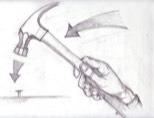
Click here to view the Gallery. -
Perspective DrawingRudolf Steiner, the progenitor of Waldorf education, contended that the official beginning of the Renaissance occurred in 1413, when the laws of perspective were discovered. So it is especially appropriate for this block to be taught in Grade Seven. It is a good block with which to begin the school year, because seventh graders may benefit from learning to view the outer world -- and their inner life -- from any number of perspectives, without jumping to the conclusion that only one point of view is correct.

Click here to view the Gallery. -
World LanguagesRudolf Steiner insisted that students in the Waldorf grade school should learn two world languages in addition to their "mother tongue." For many years, Waldorf schools in the USA taught German and French, but in the twenty first century there are many more schools teaching Spanish, Mandarin, Japanese, or Russian. In the first three grades the children learn the new language the way they learned their native language -- orally, through games, poems, songs, and conversation. In Grade Four they begin to write in the language, and by Grade Seven a degree of fluency may have been attained that is also reflected in their written work. The student work on view here was created by the last group of students to study French in Green Meadow Waldorf School.

Click here to view the Gallery.
-
-
Grade 8 Galleries
-
History: Reform & RevolutionThe History curriculum in Grade Eight is much less structured than in earlier grades. A teacher may feel that one class still needs more immersion in the Renaissance before plunging into the icy and less aesthetic waters of the Reformation, while another teacher may have dealt with Luther and Copernicus in Grade Seven and is ready to rush headlong into the series of revolutions that transformed the world from the 17th through the 20th centuries. Although the work covered in this slideshow generally represents Grade Eight History, every eighth grade has its own historical character.
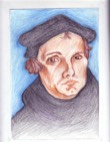
Click here to view the Gallery. -
Laboratory Science: PhysicsThe Grade Eight class teacher will generally work with several topics in the course of a three to four-week main lesson block: Acoustics, Optics, Mechanics, Hydraulics, Pneumatics, Electricity, and Magnetism. We will be looking at student work drawn from the latter two topics. Electricity and Magnetism draw students very much into the here-and-now, but also give them an historical survey of the way in which these forces were discovered, understood, and utilized -- and how these three stages were sometimes separated by centuries.
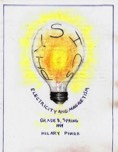
Click here to view the Gallery. -
Laboratory Science: ChemistryThe primary study in Grade Seven was Inorganic Chemistry, and in Grade Eight Organic Chemistry comes to the fore. The study of carbohydrates, protein, and fats and oils complements the exploration of the digestive system that engaged the students in Grade Seven, who are still deeply interested in such questions as, "Is it snack time yet?" and "Why is our lunch period so late this year?" Chemistry classes become cooking classes and vice-versa, as eighth graders begin to become more conscious of the importance of the food choices that they make every day.
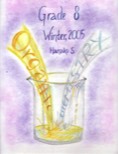
Click here to view the Gallery. -
Geometry in NatureThe Geometry in Nature block is the culmination of the students' work over the years in Form Drawing, Geometry, and Mathematics. Among the topics studied are the Fibonacci Series, the mathematical ratio "phi" (aka the "Golden Proportion") and its infinite iterations throughout the natural world and in the world of human creation. In relation to their studies in Human Anatomy, eighth graders may also examine the proportions of human figures painted and sculpted by Renaissance masters, and study their own proportions as well.
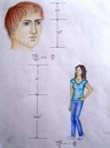
Click here to view the Gallery. -
Natural Science: MeteorologyWith its unpredictability, its endless polarities, and its capacity for bringing joyous serenity as well as uncontrollable destruction, the weather is a helpful metaphor for that phase of human life called adolescence. It is not surprising that the study of Meteorology is one of the eighth grade's favorite main lesson blocks. In addition to the "objective correlative" it provides to the eighth grader's soul state, Meteorology also connects to the growing political, sociological, and environmental issues linked to climate change and the phenomenon of global warming.
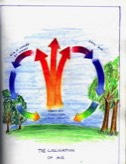
Click here to view the Gallery. -
Natural Science: Human AnatomyThe final Natural Science subject studied in the Waldorf grade school is Human Anatomy. Now the eighth grader comes face-to-face with the skeleton, that part of our body which is universal, and yet which serves our unique destiny as we move and act throughout our life. I was always impressed with the existential relationship that many eighth graders have with this main lesson block, as they, in the fulness of their lives, face the image of death. The "self-portraits" that conclude this gallery presentation reveal the intensity of this relationship -- and the humor that it nonetheless evokes.
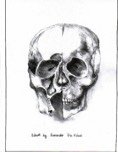
Click here to view the Gallery.
-
-
Science in the Waldorf Grade SchoolThis slideshow presents a rich survey of the natural sciences and laboratory sciences curriculum of Grades Four through Eight in the Waldorf school. Hyperlinks make it possible to experience the complex interweaving of the various subjects as the student moves from grade to grade. Eugene Schwartz’s insightful commentary points to the relationship of the sciences to every other aspect of the Waldorf student’s experience. NOTE: This presentation is very big — it contains over 175 slides, and many of those slides have several layers of imagery. For this reason it is available only as a downloadable PowerPoint file. Once you have downloaded it, it can be played on your computer’s PowerPoint software (if you have a PC), or it can be opened as a KeyNote slideshow (on a Mac). Some of the animations and transitions will not be fully functional in Keynote.

Click here to view the Slideshow
-
Go to the Grades 1-4 Student Work GalleriesClick here to visit our extensive galleries of work by Waldorf students in Grades One through Four.
Help Us Keep These Resources Free
Become a Member of MillennialChild.com. Members help provide the software and Internet services that make these valuable Waldorf resources available to tens of thousands of people annually — and keep MillennialChild.com free of advertising.
Annual Members receive a 30% discount on CD Downloads and one free phone consultation a year with Eugene Schwartz.
Click here for more information.
